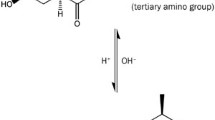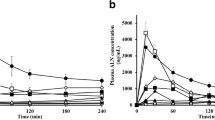Abstract
Purpose. The purpose of the present study is to clarify the intestinal brush-border transport mechanism of a weak organic acid, pravastatin, an HMG-CoA reductase inhibitor.
Methods. The transport of pravastatin was studied by using intestinal brush-border membrane vesicles prepared from rabbit jejunum, and uptake by the membrane vesicles was measured using rapid filtration technique.
Results. The initial uptake of [14C]pravastatin was markedly increased with decreases in extravesicular pH and showed a clear overshoot phenomenon in the presence of a proton gradient (pHin/out = 7.5/5.5). A protonophore, carbonylcyanide p-trifluoromethoxyphenylhydrazone, significantly reduced the uptake of [14C]pravastatin. In addition, an ionophore for sodium, potassium and proton, nigericin, stimulated the uptake of [14C]pravastatin in the presence of a potassium gradient ([K + ]in/[K+ ]out = 0/145 mM). On the other hand, neither the imposition of an inwardly directed sodium gradient nor an outwardly directed bicarbonate gradient stimulated the uptake of [14C]pravastatin. In the presence of a proton gradient (pHin/out = 7.5/5.5), the initial uptake of pravastatin was saturable with the apparent Kt of 15.2 ± 3.2 mM and Jmax of 10.6 ± 1.21 nmol/mg protein/10 sec. The uptake of pravastatin was significantly inhibited by monocarboxylic acid compounds such as acetic acid and nicotinic acid in a competitive manner but not by di- or tri-carboxylic acids, or acidic amino acid.
Conclusions. It was concluded that a pH-dependent transport of pravastatin across the brush-border membrane occurs by a proton-gradient dependent carrier-mediated mechanism rather than by simple diffusion of its unionized form.
Similar content being viewed by others
REFERENCES
B. B. Brodie and C. A. M. Högben. Some physico-chemical factors in drug action. J. Pharm. Pharmacol. 9:345–380 (1957).
A. Tsuji, M. T. Simanjuntak, I. Tamai, and T. Terasaki. pH-Dependent intestinal transport of monocarboxylic acids: Carrier-mediated and H+-cotransport mechanism versus pH-partition hypothesis. J. Pharm. Sci. 79:1123–1124 (1990).
M. T. Simanjuntak, T. Terasaki, I. Tamai, and A. Tsuji. Participation of monocarboxylic anion and bicarbonate exchange system for the transport of acetic acid and monocarboxylic acid drugs in the small intestinal brush-border membrane vesicles. J. Pharmacobio-Dyn. 14:501–508 (1991).
M. T. Simanjuntak, I. Tamai, T. Terasaki, and A. Tsuji. Carrier-mediated uptake of nicotinic acid by rat intestinal brush-border membrane vesicles and relation to monocarboxylic acid transport. J. Pharmacobio-Dyn. 13:301–309 (1990).
A. Tsuji, H. Takanaga, I. Tamai, and T. Terasaki. Transcellular transport of benzoic acid across Caco-2 cells by a pH-dependent and carrier-mediated transport mechanism. Pharm. Res. 11:30–37 (1994).
H. Takanaga, I. Tamai, and A. Tsuji. pH-Dependent and carrier-mediated transport of salicylic acid across Caco-2 cells. J. Pharm. Pharmacol. 46:567–570 (1994).
T. Koga, Y. Shimada, M. Kuroda, Y. Tsujita, K. Hasegawa, and M. Yamazaki. Tissue-selective inhibition of cholesterol synthesis in vivo by pravastatin sodium, 3-hydroxy-3-methylglutaryl coenzyme A reductase inhibitor. Biochim. Biophys. Acta 1045:115–120 (1990).
T. Komai, E. Shigehara, T. Tokui, T. Koga, M. Ishigami, C. Kuroiwa, and S. Horiuchi. Carrier-mediated uptake of pravastatin by rat hepatocytes in primary culture. Biochem. Pharmacol. 43:667–670 (1992).
M. Yamazaki, H. Suzuki, M. Hanano, T. Tokui, T. Komai, and Y. Sugiyama. Na+-independent multispecific anion transporter mediates active transport of pravastatin into rat liver. Am. J. Physiol. 264:G36–44 (1993).
T. Komai, K. Kawai, T. Tokui, Y. Tokui, C. Kuroiwa, E. Shigehara, and M. Tanaka. Disposition and metabolism of pravastatin sodium in rats, dogs and monkeys. Eur. J. Drug Metab. Pharmacoki. 17:103–113 (1992).
D. E. Duggan, I. W. Chen, W. F. Bayne, R. A. Halpin, C. A. Duncan, M. S. Schwartz, R. J. Stubbs, and S. Vickers. The physiological disposition of lovastatin. Drug Metab. Dispos. 17:166–173 (1989).
S. Vickers, C. A. Duncan, I. W. Chen, A. Rosegay, and D. E. Duggan. Metabolic disposition studies on simvastatin, a cholesterol-lowering prodrug. Drug Metab. Dispos. 18:138–145 (1990).
A. Tsuji, A. Saheki, I. Tamai, and T. Terasaki. Transport mechanism of 3-hydroxy-3-methylglutaryl coenzyme A reductase inhibitors at the blood-brain barrier. J. Pharmacol. Exp. Ther. 267:1085–1090 (1993).
A. Tsuji, T. Terasaki, I. Tamai, and H. Hirooka. H+ gradient-dependent and carrier-mediated transport of cefixime, a new cephalosporin antibiotic, across brush-border membrane vesicles from rat small intestine. J. Pharmacol. Exp. Ther. 241:594–601 (1987).
M. M. Bradford. A rapid and sensitive method for the quantitation of microgram quantities of protein utilizing the principle of protein-dye binding. Anal. Biochem. 72:248–254 (1976).
Author information
Authors and Affiliations
Rights and permissions
About this article
Cite this article
Tamai, I., Takanaga, H., Maeda, H. et al. Proton-Cotransport of Pravastatin Across Intestinal Brush-Border Membrane. Pharm Res 12, 1727–1732 (1995). https://doi.org/10.1023/A:1016269806840
Issue Date:
DOI: https://doi.org/10.1023/A:1016269806840




